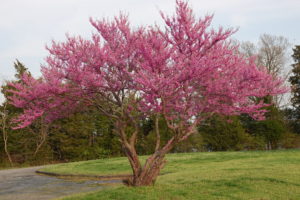Uncategorized
Eastern Redbud March 2021 Plant of the Month
By Betsy Washington Northern Neck Chapter, Virginia Native Plant Society As signs of spring fill the air, I find myself eagerly anticipating the vibrant magenta pink blooms of one of our most beautiful flowering trees, the Eastern Redbud, Cercis canadensis. This small tree is a common sight along roadsides, woodland edges, and old fields…
Read MoreCommon Hackberry February 2021 Plant of the Month
By Betsy Washington, Northern Neck Chapter The Common Hackberry is one of our most adaptable native shade trees and is also among the best trees to plant for wildlife. The trunk of hackberries has smooth…
Read MoreAmerican Beech January 2021 Plant of the Month
By Betsy Washington Northern Neck Chapter, VNPS American Beeches are one of our most magnificent native trees, beautiful in every season, especially winter. They are also one of the most easily recognized of our eastern deciduous trees, with their silvery gray bark that appears cast…
Read MoreSkunk Cabbage December 2020 Wildflower of the Month
By Betsy Washington Northern Neck Chapter, Virginia Native Plant Society As the winter solstice approaches, I am already anticipating the blooms of our earliest spring wildflower, Skunk Cabbage, Symplocarpus foetidus. The buds of this winter blooming wildflower begin to appear in our…
Read MoreJoe pye weed September 2020 Wildflower of the Month
By Helen Hamilton John Clayton Chapter These tall, majestic plants are real butterfly magnets. Blooming in late summer until frost, they range from 3 to 10 feet tall with dense heads of fluffy pinkish flowers that are usually covered with butterflies, bees, beetles and wasps, all feeding and pollinating. When in flower, Joe-pye-weeds can be…
Read MoreMistflower August 2020 Wildflower of the Month
MISTFLOWER and Monarch Butterflies Conoclinium coelestinum (formerly Eupatorium coelestinum) This is one of the native perennials highly regarded as nectar food for monarch butterflies. The typical life cycle of monarchs includes four flights each year, the third in July-August, and the last September-October that produces a different butterfly, capable of the long migration south. Monarchs…
Read MoreMountain mint July 2020 Wildflower of the Month
Mountain-mint Pycnanthemum tenuifolium/muticum By Helen Hamilton John Clayton Chapter, VNPS What’s not to like about a native perennial that is attractive to bees and butterflies, does not spread aggressively, and is deer-resistant? Mountain-mints bloom from June through August, with small white flowers rich in nectar that is food for many kinds of insects – butterflies,…
Read MoreSpiderwort June 2020 Wildflower of the Month
By Helen Hamilton A long-blooming native perennial like Spiderwort can fit into a lot of spaces in the home garden. Three-petaled flowers form a triangle – they are violet-blue with vivid yellow stamens growing in a 3’ tall clump. Each flower is open for only a day, in the morning, but they bloom in succession…
Read MoreRed Columbine May 2020 Wildflower of the Month
By Helen Hamilton This is one of our loveliest early spring flowers, with hanging red flowers that have long spurs and yellow centers. The nectar at the base of the spurs attracts long-tongued insects and hummingbirds. The flowers are mature when migrating hummingbirds appear in our area, and are important food for these little birds,…
Read MoreGolden Ragwort April 2020 Wildflower of the Month
By Helen Hamilton Golden Ragwort is a welcome sign of spring, covering swampy areas with bright yellow, from mid-March through early summer. The buds are purple, and open to display yellow disc and ray flowers, unusual for a member of the Aster Family — the rays are often white. This native perennial grows 1-3 feet…
Read More









